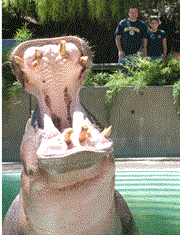
 Creative research is like assembling a complex puzzle, according to Christopher Viney, a professor in UC Merced's School of Engineering. Multiple pieces must be brought into place: ideas, people, equipment and funding. Unlike many other researchers, though, Viney draws personnel from local high schools, and his unusual equipment list can include - of all things - a hippopotamus.
Creative research is like assembling a complex puzzle, according to Christopher Viney, a professor in UC Merced's School of Engineering. Multiple pieces must be brought into place: ideas, people, equipment and funding. Unlike many other researchers, though, Viney draws personnel from local high schools, and his unusual equipment list can include - of all things - a hippopotamus.
In summer 2004, Viney studied hippo sweat (a red secretion produced by the animal's skin) with help from Merced High School student Amber Zielinski. Viney originally hired Zielinski as a lab assistant, but he soon found the 15-year-old water polo player had a lot more to offer.
Amber demonstrated a work ethic better than many older students, Viney said. And she has extraordinary powers of anticipation. Together, they assembled a brand-new microscope, and Viney says Zielinski always seemed to know what part they would need next and where it went.
Viney and Zielinski traveled to the Chaffee Zoo in Fresno to collect sweat samples from Bulgy the hippo. With help from Bulgy's keeper, they developed a humane and efficient sweat collection technique.
They planned to look at how molecules in the sweat are arranged, hoping to determine why the secretion has sunscreen properties. They also observed that flies in Bulgy's habitat never landed on his sweat, indicating insect repellent potential. And by reading other researchers' observations, they realized that although hippos regularly sustain wounds in territorial battles, those wounds are rarely infected, in spite of markedly unsanitary surroundings. So the sweat may have antiseptic properties. It's water-resistant, too.
Using the microscope, Viney and Zielinski found that the sweat's molecular organization not only creates beneficial properties, it creates beautiful pictures resembling everything from swarms of insects to mountain ranges to rings of fire. Polarized light brought out different color schemes in the sweat, indicating different properties of its structure.
You won't find a bottled replica of hippo sweat at your drugstore quite yet. Viney plans two to three scientific papers based on the summer's research, and applying that knowledge to creating good products for people to use will take still more time and work. But learning how other species cope with natural obstacles to good health may ultimately benefit everyone under the sun.






